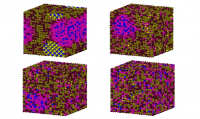A new alloy can withstand extreme conditions

Structure of the alloy W29.4Ta42.0V16.1Cr5.0Hf7.5 obtained with Monte Carlo simulations, based on ab initio calculations for four different temperatures: 300 K, 620 K, 1000 K and 1500 K
It is nanocrystalline, fireproof and has high entropy. Thanks to this it may be used, for example, in nuclear power engineering or space industry. Such alloy is studied by an international research team, which includes a researcher from the Warsaw University of Technology.
The latest result of their work is the paper "A quinary WTaCrVHf nanocrystalline refractory high-entropy alloy withholding extreme irradiation environments", published in the journal "Nature Communications". It is co-authored by Jan Wróbel, PhD, from the Faculty of Materials Science and Engineering.
Decreasing the emission of greenhouse gases and limiting the resulting consumption of fossil fuels is at present one of the main global challenges. An alternative to traditional resources may be, for instance, nuclear power. This is an area for researchers seeking new materials that can withstand extreme conditions in power plants. One of them is the alloy W-Ta-Cr-V-Hf described in ”Nature Communications”.
– It is fireproof and, like W-Ta-Cr-V we studied earlier, highly resistant to radiation – explains Jan Wróbel, PhD. – In comparison with the previous one, it has significantly better microstructural stability, resulting from large density of stable grain boundaries, chemical complexity and lower temperature at which brittle intermetallic phases occur in the alloy.
The new alloy was designed on the basis of computer simulations conducted in cooperation with our researcher.
– We used ab initio methods, based on quantum mechanics, combined with statistical methods which I use in my research on design of multicomponent metal alloys – says Jan Wróbel, PhD.
Experimental results and simulations are coherent, which shows that the design method presented by the team may be used to develop and synthetise new high-entropy alloys for various applications. In future it is planned to further optimize the composition of the alloy to find a material that could be an alternative to pure wolfram for applications in the most demanding structural element of nuclear fusion reactors, i.e., the divertor.
The publication was the joint work of researchers from the Los Alamos National Laboratory, Oak Ridge National Laboratory, Argonne National Laboratory and universities: Wisconsin-Madison, Clemson, Oxford, Middle East Technical University in Ankara. Oxford and Warsaw University of Technology researchers did their work within the European project EUROfusion.







